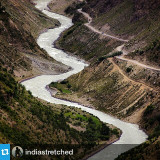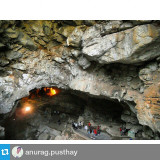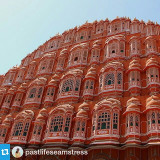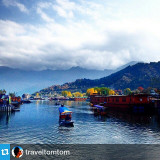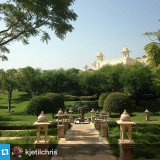Random image from our India photo collection
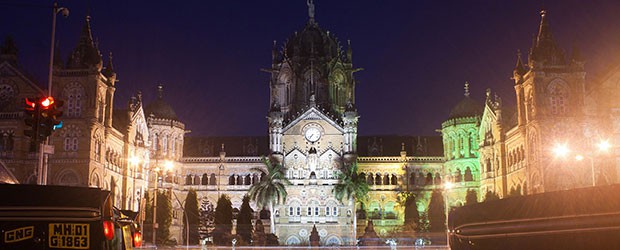
Gujarat
Tourist Centers
Ahmedabad is known for its rich past and its association with Mahatma Gandhi. The city has a unique style of architecture, which is a blend of Hindu and Islamic styles (Indo-Saracenic style of architecture). The monuments of Ahmedabad date back to the 15th century. Ahmedabad has been known for its industry since medieval times. Presently it is famous for its textile mills and is often referred to as the 'Manchester of the East'.
Gandhinagar is situated about 25 kilometers north of Ahmedabad and is the newly built capital of Gujarat. Gandhinagar was named after Mahatma Gandhi. The presence of abundant flora here has earned it the title of the 'Green Capital'.
Jamnagar is situated in the Saurashtra region. Major sites here include the Lakhota Fort, Kotha Bastion, Willington Crescent, Solarium, Jamsaheb's Palace, and Rozi and Bedi ports.
Patan lies further north of Jamnagar, founded during the 9th century. The city is famous for its architectural wonders built during the rule of the Solanki dynasty. The Rani Udayamati vav (step well) and the Sahastralinga Lake are some of the tourist attractions here.
To the south of Ahmedabad lies the city of Vadodara, Gujarat's cultural capital, which has a long tradition of music, fine arts and education.
A favorite hill resort for the people of Vadodara is Pavagadh, which is believed by many to be the chunk of the Himalayas that was carried by Hanuman to Lanka.
At the base of the Pavagadh hill is Champaner, the ancient capital of Sultan Mahmud Beghara. The Jama Masjid is situateds here which is considered to be one of the finest in the State.
Further south of Vadodara lies the important trading center and port of ancient India called Surat. Today, Surat is an important center for textiles, gold and silver threadwork and diamond cutting and polishing.
Saputara is Gujarat's best-known hill resort, situated atop the second highest plateau in the Sahyadri range.
Rajkot had been the scene of many clashes between the Mughals and the British. It is located in the center of the peninsula further northwest of Surat and the city is mainly known for the handicrafts it produces. It is famous for its bead and mirror work, tie and dye (bandhani), silk embroidery and appliqué work.
To the southeast of Rajkot is the city of Bhavnagar. The prime attraction here is a Mahadev Temple.
To the west of Bhavnagar, situated at the base of the Girnar Hills is Junagadh. It is famous for its rock edict of Emperor Ashoka, dating back to 250 BC.
One of the biggest attractions about five kilometers from Junagadh is Uperkot. The fort is atop the Uperkot hill and was originally constructed by the Rajputs. It has an ornamented triple gateway. Equally fascinating here are the Buddhist caves and stupa all dating back to 100-700 AD.
Further west of Junagadh, situated along the coast is Porbandar, the birthplace of Mahatma Gandhi.
Known popularly as the gateway to Kutch, Bhuj is the most important town in this region. It is an old walled city, the gates of which were locked from dusk to dawn in the olden times. It encloses within itself not only the palace but also the entire bazaar and a lake too.
Situated in Junagadh, near the port town of Veraval, Somnath is probably one of the best-known pilgrimage centers of Gujarat.
Yet another pilgrimage, for which this state is known, is the holy town of Dwarka lying on the northern tip of the Saurashtra peninsula which is the flowing together of the Gomti River and the Arabian Sea.
One of the most sacred pilgrimage centers for the Jain community, situated in Junagadh district, is the 16 marble temples atop the 1,118-meter high Mount Girnar.
Located on the 600 meter high Shatrujaya Hill, the magnificent 863 architectural temples of Palitana, dedicated to various Jain saints and deities, is yet another important place of pilgrimage on the Jain circuit.
Go back
Gandhinagar is situated about 25 kilometers north of Ahmedabad and is the newly built capital of Gujarat. Gandhinagar was named after Mahatma Gandhi. The presence of abundant flora here has earned it the title of the 'Green Capital'.
Jamnagar is situated in the Saurashtra region. Major sites here include the Lakhota Fort, Kotha Bastion, Willington Crescent, Solarium, Jamsaheb's Palace, and Rozi and Bedi ports.
Patan lies further north of Jamnagar, founded during the 9th century. The city is famous for its architectural wonders built during the rule of the Solanki dynasty. The Rani Udayamati vav (step well) and the Sahastralinga Lake are some of the tourist attractions here.
To the south of Ahmedabad lies the city of Vadodara, Gujarat's cultural capital, which has a long tradition of music, fine arts and education.
A favorite hill resort for the people of Vadodara is Pavagadh, which is believed by many to be the chunk of the Himalayas that was carried by Hanuman to Lanka.
At the base of the Pavagadh hill is Champaner, the ancient capital of Sultan Mahmud Beghara. The Jama Masjid is situateds here which is considered to be one of the finest in the State.
Further south of Vadodara lies the important trading center and port of ancient India called Surat. Today, Surat is an important center for textiles, gold and silver threadwork and diamond cutting and polishing.
Saputara is Gujarat's best-known hill resort, situated atop the second highest plateau in the Sahyadri range.
Rajkot had been the scene of many clashes between the Mughals and the British. It is located in the center of the peninsula further northwest of Surat and the city is mainly known for the handicrafts it produces. It is famous for its bead and mirror work, tie and dye (bandhani), silk embroidery and appliqué work.
To the southeast of Rajkot is the city of Bhavnagar. The prime attraction here is a Mahadev Temple.
To the west of Bhavnagar, situated at the base of the Girnar Hills is Junagadh. It is famous for its rock edict of Emperor Ashoka, dating back to 250 BC.
One of the biggest attractions about five kilometers from Junagadh is Uperkot. The fort is atop the Uperkot hill and was originally constructed by the Rajputs. It has an ornamented triple gateway. Equally fascinating here are the Buddhist caves and stupa all dating back to 100-700 AD.
Further west of Junagadh, situated along the coast is Porbandar, the birthplace of Mahatma Gandhi.
Known popularly as the gateway to Kutch, Bhuj is the most important town in this region. It is an old walled city, the gates of which were locked from dusk to dawn in the olden times. It encloses within itself not only the palace but also the entire bazaar and a lake too.
Situated in Junagadh, near the port town of Veraval, Somnath is probably one of the best-known pilgrimage centers of Gujarat.
Yet another pilgrimage, for which this state is known, is the holy town of Dwarka lying on the northern tip of the Saurashtra peninsula which is the flowing together of the Gomti River and the Arabian Sea.
One of the most sacred pilgrimage centers for the Jain community, situated in Junagadh district, is the 16 marble temples atop the 1,118-meter high Mount Girnar.
Located on the 600 meter high Shatrujaya Hill, the magnificent 863 architectural temples of Palitana, dedicated to various Jain saints and deities, is yet another important place of pilgrimage on the Jain circuit.
Go back


